The 19th-century Swiss historian Jacob Burckhardt described a particular type of northern visitor to the Italian peninsula as believing the land and its riches were theirs “by right of admiration”. As in most possessive relationships, this admiration often takes the form of critique. How, cry those from the frigid north, can the country of Virgil, Michelangelo and spaghetti alle vongole also be the one of Berlusconi, calciopoli and the ubiquitous bagno? Well, the first two have ceased to be, and the latter is under threat too. Up and down the Bel Paese, activists are campaigning against the provision of tenders to run bagni – private beach clubs that charge admission in return for a deckchair, umbrella and, sometimes, waterside table service – arguing that they are undemocratic, corrupt, even an offence to aesthetics. But while disgruntled natives are at least righteous in their bagno-turismo, those snooty outsiders who believe that there is some incongruity between the Sistine Chapel and a sea of a thousand umbrellas are mistaken.

Bagni are not the vulgar symptoms of a corrupt modern capitalism that has flourished on Italian shores. They are civilising spaces, springing as they do from a particular native fastidiousness when it comes to comfort and cleanliness, combined with a recognition that, in the land of sprezzatura and bella figura, life is in large part a performance for which you need an audience, preferably a captive one with somewhere comfortable to lie down. Unlike repressed northerners with their plentiful barren space and obsession with privacy, most Italians live in crowded apartment buildings and so are comfortable with physical proximity. They do not need to imbibe hectolitres of grog to become voluble or lose their inhibition to casual touch.
And yet, my imaginary northern interlocutor screams back, no doubt pink in the face, that the experience of bathing on an empty beach is so much nicer than in a bagno. To which I reply, is it really? Anyone whose formative beach experiences were spent squirming atop uneven pebbles or shivering behind nylon windbreakers can appreciate the quiet luxury of a towel, table and deckchair of one’s own. And if you can’t understand the physical pleasure then surely you can acknowledge the collegiality. Italians don’t really have the private members’ clubs or hobbyist societies that northern Europeans do. But they do have the bagno, where people of all ages and social groups can rub sun-creamed shoulders together for a relatively modest fee – and theirs is a more egalitarian society for it. Swimming trunks are the great leveller. As Shirley Hazzard, a more receptive visitor than most, wrote: “Italy, which harbours mysteries and arouses imagination, does not supply solutions.” The sentiment is beautiful but only half-true. For surely the solution to having nowhere comfortable and shaded to sit on the beach is to visit a bagno.
Self is Monocle’s foreign editor. For more Med-based musings and sunny essays, pick up a copy of Monocle’s new ‘Mediterraneo’ newspaper today.
Is the world’s leading research-and-development (R&D) nation scaring away its best and brightest? As relations between the Trump administration and American universities grow increasingly confrontational – and sweeping cuts to government funding put thousands of scientific jobs in limbo – up to 75 per cent of US-based scientists say that they are considering leaving the country.
But the US’s loss could be Europe’s gain. The number of top researchers looking for a more welcoming environment is just the opportunity to start closing the R&D gap that has long existed between the Old Continent and the US.

Andrew Michael Liebhold is one such example. After almost four decades at the US Forest Service (USFS), the research entomologist accepted an offer to become chief scientist at the Czech University of Life Sciences in Prague, which funded his position with the help of investments by the European Commission.
“It turns out that I got out just in time,” Liebhold tells Monocle. A few months after his move, his previous department at the USFS – with roughly 1,500 staff, nearly a third of whom hold doctorates – came under threat when the Trump administration proposed major cuts to its funding by 2026. “I’ve received phone calls from former colleagues who are afraid they will be out of a job soon.”
The USFS is far from the only example. The National Oceanic and Atmospheric Administration (NOAA), which conducts critical climate studies, is also being targeted by the White House. Meanwhile, the National Institute of Health (NIH), which has supported some of the highest-quality research on healthcare and medicine, has already cancelled nearly $2bn (€1.7bn) in federal grants to US institutions. The breadth and depth of these cuts has led to thousands of scientists and researchers losing funding for their studies – and even their jobs. “The Trump administration’s logic seems to be that if we don’t research an issue, then it will go away – at least from the public sphere,” says Liebhold.
France has been especially active in efforts to capitalise on the uncertainty in the US. In 2017, Emmanuel Macron called on nations to “Make our planet great again,” inviting US climate scientists to work in France, after Donald Trump pulled his country out of the Paris Climate Accords. In May this year, France also launched a new national programme called “Choose France for Science”. Macron has since announced that additional funds would draw scientists from across disciplines, insisting that his nation “must become a refuge”.
Aix-Marseille University in the south of France has already welcomed new US recruits – and is set to hire more. “Our colleagues in the US are restricted in their academic freedom,” says the university’s president, Eric Berton. “It’s in reaction to this that we have created our programme to grant them scientific asylum.” To date, the university has received hundreds of applications from researchers at institutions including Columbia, Harvard, MIT and Nasa.
For many scientists who are out of a job, or fear that they soon will be, the prospect of a fresh start in Europe will appeal, despite lower salaries and budgets. With France even considering a scientific refugee status as a result of the US exodus, the country is laying the groundwork to capture that talent. While the US shoots itself in the foot, Europe might receive a shot in the arm.
Thailand has once again found itself in a political crisis. The Constitutional Court has suspended prime minister Paetongtarn Shinawatra pending an investigation into her conduct and protestors are taking to the streets to demand her resignation. Meanwhile, Shinawatra’s Pheu Thai party is under pressure from the opposition to call fresh elections or face a vote of no confidence. As tensions in Bangkok rise, talk of military intervention is back in the news, raising the prospect of another Shinawatra-led government ending in a coup d’état.
Amid the mayhem, Pita Limjaroenrat is stepping back into the spotlight to publish his political memoir, The Almost Prime Minister. Limjaroenrat was the former leader of Thailand’s now defunct Move Forward party and was on course to become the kingdom’s prime minister after the most recent election in 2023. However, he too was suspended by the Constitutional Court and was later banned from politics for 10 years. Pheu Thai finished second to Move Forward and went from supporting Limjaroenrat for prime minister to leading its own coalition government, which is now teetering on a knife’s edge.
Monocle sat down with Limjaroenrat in Bangkok to discuss the political merry-go-round, neighbourly chats with the former prime minister of New Zealand, Jacinda Ardern and the chances of the People’s Party (the successor to Move Forward) winning the next election.
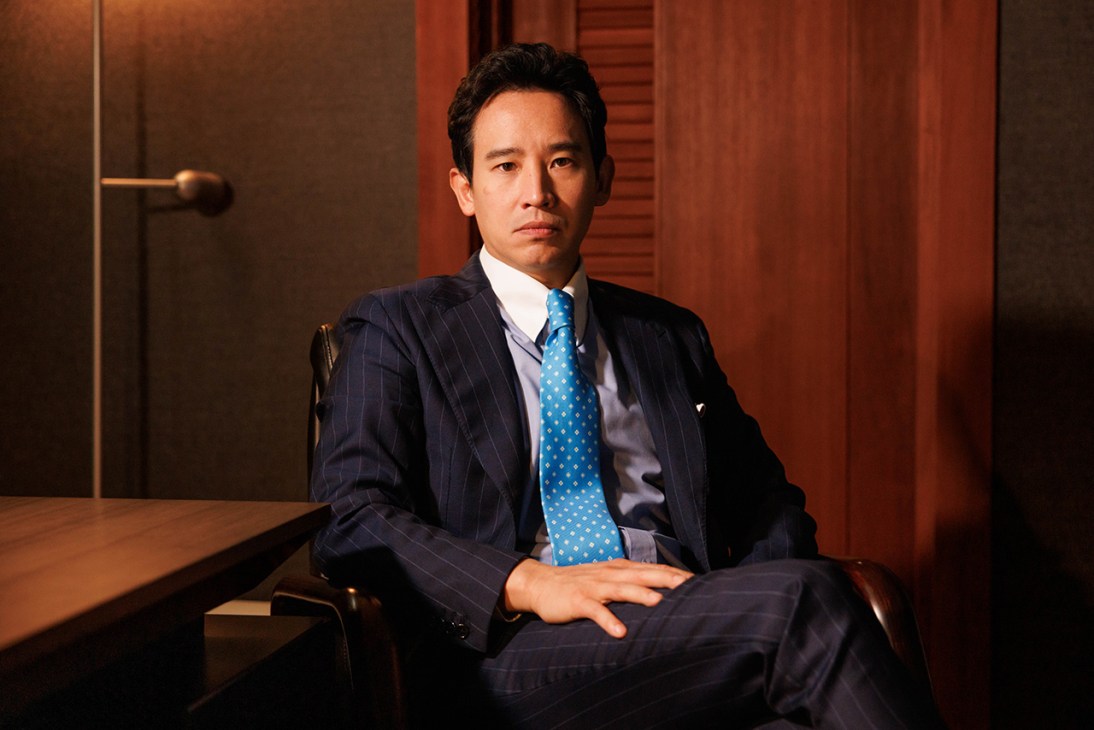
What have you been doing since you almost became prime minister?
I went to Boston to become a senior fellow at Harvard University. My ban [from Thai politics] is for 10 years and I have nine more years to burn, so I’m travelling the world and trying to help the next generation of leaders.
It sounds like you would still like to be prime minister one day.
I’m waiting for my time. I want to bring about the reforms that I promised two years ago for the people who voted for me. But if Thailand changes in the next nine years, I won’t need to return.
Are you feeling slightly glad that you’re not prime minister right now?
No, not really. I had lots of things that I wanted to achieve and I’m really disappointed that I couldn’t fulfill any of them. Thailand needed a strong government to deliver and we had the mandate for it. Unfortunately, Pheu Thai didn’t come through.
What do you make of the Thai government’s current crisis?
Thais want the prime minister [Paetongtarn Shinawatra] to resign because she has neither the common sense nor the efficiency to take on the challenges that the country is facing. That’s the zoom-in part. But the zoom-out part is that Thai politics is deadlocked by design. It was organised by the military junta to ensure that the constitution includes mechanisms for changing the election outcome. That happened to me and it’s what’s hitting her as well. The judiciary is clearly outperforming the other branches of government.
Could there be another military coup in Thailand?
That is a possibility because of the normalisation of coups. Something that’s abnormal has become quite normal in Thailand. It’s really up to us Thai to make sure that we don’t allow that to happen.
What prompted you to write a book about your experiences?
When I moved to Boston, my neighbour was Jacinda Ardern. She was writing her political memoir and she inspired me to do the same. Another person [who influenced me] was Sanna Marin, the former prime minister of Finland. We met in South Korea and she was also writing her memoir.
Did you genuinely believe that you had a shot at becoming prime minister?
I’m a finance guy, so I had my scenario analysis. I thought that there was a 15 per cent chance that I wouldn’t become prime minister. We had to plan for this outcome and we tried every single resource to make sure that it didn’t happen. Obviously it did happen – but I wasn’t naive. I didn’t assume that we’d get the chance to govern just because we got the most votes.

When did you realise that it was all over for you?
There was a brown envelope on my desk in the parliament informing me that [the Constitutional Court] was suspending me and that it was going to take its time. They suspended me for six months. Thailand needed a leader, so that’s why Srettha Thavisin stepped up and became the prime minister, even though he didn’t win the votes.
Could you or your party have done anything differently to change the outcome?
I would have done the same but with more detailed explanations. Before the election, I would have met with our supposed opponents – whether that’s the military, the monopolies or the media – looked them in the eye, answered their questions and explained to them what we wanted to achieve. That’s what we need to do now: open a dialogue.
Can a clean political party win power?
Absolutely. I feel like we have found the secret sauce. I teach about it at Harvard – I call it “precision politics”. To precisely employ your resources without using a lot of money, you need to use the “four Cs” framework. Is our candidate strong? Is the competitor weak? Is the constituency relatively young? And has our vote count gradually increased in the past four years? We prioritised 160 districts in Thailand based on precision politics and won 151 of them.
Do you worry about your supporters losing faith?
Voter fatigue is something that we are worried about and you never know what’s going to happen in Thai politics. Our poll numbers are very good but the ruling elite is cooking something up – I can smell it from the Sukhumvit area. They want to make sure that the choice of the majority does not translate into a government. The election is the last contest that we have a chance of winning. If the voting turnout is below 70 per cent, I can guarantee that we’re not going to win. If the voting turnout is more than that, we have a chance to win – and win big.
What leadership advice would you give to your successor, Natthaphong Ruengpanyawut?
Take your time. It’s a crystallisation process that takes time, pressure and heat. Take the pressure, take the heat and take your time and then you’ll be able to shine like a diamond. When I started, my poll numbers were at three per cent and I ended up with 46 per cent. He’s already at 31 per cent and will emerge as an appropriate leader for Thailand.
A new law in Sweden comes into effect today that criminalises verbally abusing public officials. Lawbreakers could be punished with up to six months in prison. The legislation is the brainchild of the right-leaning government – it argues that the very institutions that exist to protect the public cannot function properly without protection from verbal abuse. “We can’t accept that Sweden’s public officials are threatened and abused. That has serious consequences for the people in question. And in the long run, it threatens our democracy and state,” said justice minister Gunnar Strömmer. In actual fact, the new law threatens to undermine the very health of the democratic institution that it aims to protect: the state.
Verbal (and physical) abuse of teachers, nurses, social workers and police is a growing problem in Sweden. There have been recent cases of schools barring parents who have been abusive towards teachers from entering school grounds. And sadly, no one is surprised to read news of hospital staff being threatened on the job. It would indeed be difficult – even stupid – to argue against protections for teachers, nurses, police officers and other public employees who slog it out to make life better for the rest of us.
Regardless, limiting free speech is an undemocratic and dangerous path to go down. Sweden has long prided itself on being an open, liberated, democratic state that welcomes differences of opinion and open discussion. What would the state become without citizens’ right to oppose it, even if they do so in less than parliamentary language? The new law could set Sweden down a road where whistleblowing becomes a freedom of the past. It could become a place where people go quiet because the state – in an effort to protect itself – has the right to decide on the definition of profanity.
The last hurrah took place yesterday in Malmö as stand-up comedians took the opportunity to play to a full house – a show chock-full of expletives directed at said public officials. The comedians, many of whom work as public employees during the daytime, were happy to see so many teachers, nurses and social workers in the audience. All having a last laugh at the profanities that could now land critics in prison.
Lewitschnik is Monocle’s Stockholm correspondent. For more news and views, subscribe to Monocle today.
Mark Twain is said to have once averred that the least that architecture could do was “improve the weather”. It’s a useful aphorism in any climate but has particular relevance to Hannibal, Missouri, along the Mississippi River, where Twain was raised (just ignore the fact that the attribution is apocryphal). In a place where the summer humidity builds to an afternoon crescendo of crackling thunderstorms, architecture has a responsibility to help and can improve people’s quality of life.
Enter the porch. In simple terms, it’s a raised platform with columns that support a canopy or roof. While it was originally just a primitive, hut-like structure, the porch today has achieved high levels of sophistication, especially in a domestic American context. Finely tuned to weather and climate, it provides shade and helps to cool the exterior of a building. It’s also a liminal space. Like a townhouse’s stoop, it has a social function beyond the privacy of a home’s interiors. It’s a vantage point, a threshold.

The porch is deeply rooted in US culture. The classic 1960 novel To Kill a Mockingbird takes place almost entirely on a veranda; in many ways, it’s a dialogue of sorts across a street between young Scout Finch and Boo Radley. In the early and mid-20th century, photojournalist Walker Evans captured numerous stoops and lives of quiet dignity in his photos of the Great Depression and New Deal America. Edward Hopper’s paintings have a porch-like quality too, while Bell Hooks’ poetry highlights porches as places of public appearance, especially for women. But the importance of this space isn’t as widely acknowledged as it should be. The US has often been viewed as a nation of houses but if you look at these buildings, from schoolhouse to house of worship, you see that their porches make them stand out.
The more I have investigated this idea, the more I have discovered that the porch – a staple of the American South – is thriving across the country. Its shape and scale are evolving. At the height of the coronavirus pandemic, a local food co-operative in Fayetteville, Arkansas, relocated to a downtown building, renovating the interiors but also constructing a broad, high veranda. It’s a simple feature with columns supporting a robust roof canopy, furniture for gathering and space to enjoy a meal or watch children playing. It’s not just the prominence that’s important; it’s also the shade, the captured breezes, the lowered temperature and the view outwards to the city’s main thoroughfare and surrounding landscape.
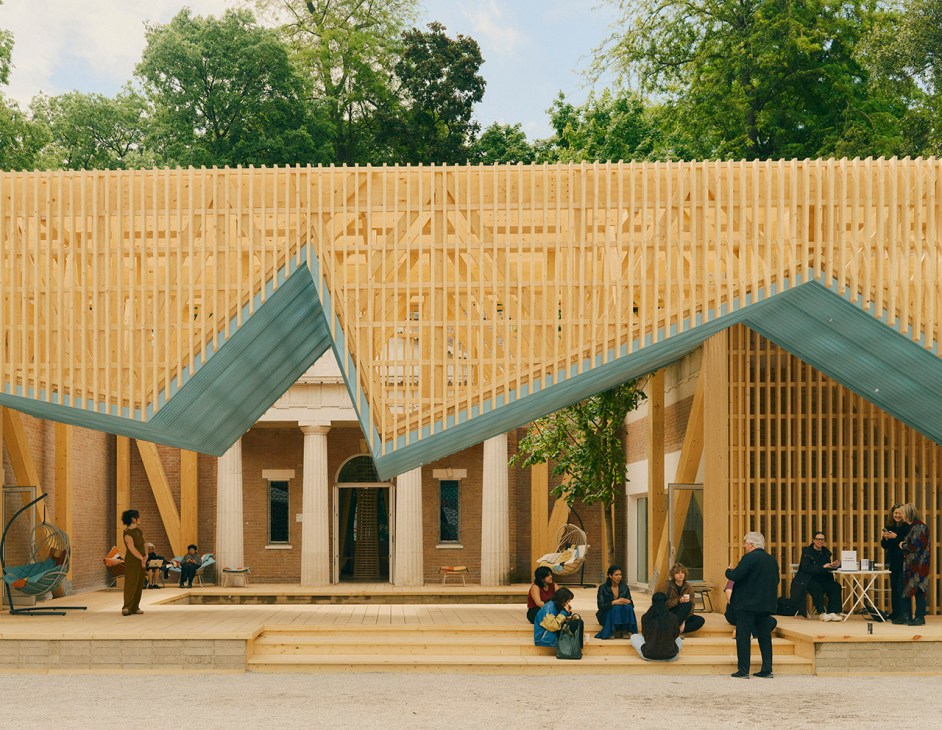
Charlie Hailey, author of The Porch: Meditations at the Edge of Nature, writes that “to think like a porch is to witness and to change our point of view”. This is what the US Pavilion at the 2025 Venice Biennale does with Porch: An Architecture of Generosity. In previous years, the Pavilion hasn’t been as accessible; putting a stoop in front of the building seemed like the obvious answer. As the name suggests, it’s a place for all to enjoy – to find respite and engage with others. Twain – or whoever made the comment – would have approved. It might not change the world but at least it improves the weather.
MacKeith is the lead commissioner for the US Pavilion at the Venice Biennale. He is also the dean and professor of architecture at the Fay Jones School of Architecture and Design, University of Arkansas.
This piece was published in ‘The Monocle Companion: Fifty Ideas on Architecture, Design and Building Better’, which is out now. The fifth title in our Companion series of paperbacks, it’s packed with fresh ideas on design, creativity and the built environment, with a focus on the 2025 Venice Architecture Biennale, which runs until 23 November.
Norman Foster is one of the world’s most celebrated architects. He established his namesake practice, Foster + Partners, in 1967, pioneering high-tech architecture through iconic structures such as Berlin’s Reichstag dome and London’s Gherkin. The Pritzker Prize laureate has redefined skylines globally over the course of five transformative decades of practice. Monocle sits down with Foster in Venice to discuss what the world should be thinking about now.
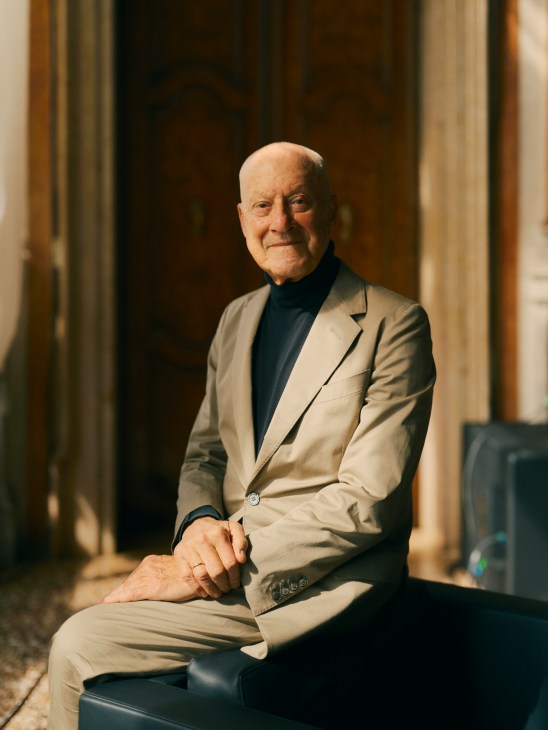
Norman Foster is one of the world’s most celebrated architects. He established his namesake practice, Foster + Partners, in 1967, pioneering high-tech architecture through iconic structures such as Berlin’s Reichstag dome and London’s Gherkin. The Pritzker Prize laureate has redefined skylines globally over the course of five transformative decades of practice. Monocle sits down with Foster in Venice to discuss what the world should be thinking about now.
We’re meeting you in Venice. Why is an event like the Biennale important?
I remember being at a gathering in Aspen, Colorado, and one of the participants was Paul MacCready, who invented a device that tells pilots the best speed to fly a glider depending on conditions. I complimented him on the achievement of his man-powered flight and he wagged his finger and said, ‘What we should be talking about are the people who set the challenge of glider flying, which we have responded to.’ Venice is setting the challenge.
And what is that challenge in Venice?
That nothing happens by accident or chance – everything around us is designed. Things are either designed well or badly. It can be done casually and without too much thought – but it’s still designed. Good design is not about how much you spend, it’s about how wisely you spend it. It all comes down to attitude. It’s important because we know that we can improve the quality of all lives through good design.
Why is quality of life an important consideration for you?
We should be talking about the quality of urban life. Cities are the future and we have to improve the quality of life in them. This is also about our pleasure and enjoyment. It’s also about beauty. All of this relates to everything from architecture and infrastructure to energy. We need to ask if we are going to get a kick out of looking at a countryside completely covered by wind turbines? Are we going to get a kick out of solar panels that have destroyed a meadow?
What are some good infrastructure and energy solutions that ensure quality of life too?
We should think about nuclear. If we come down to data and we take emotion out of it the facts are clear. Depending on the estimate, between seven and 10 million people die every year through invisible, noxious fossil-fuel fumes. A lot of those are kids burning fossil fuel for heating and cooking. As an alternative, you can take a compact nuclear battery and deliver energy that can power an entire Manhattan city block. In doing so, you take out all the dangers of centralising energy. Such an option is still by a huge margin the safest, cleanest, most compact energy solution – and you have total control of the waste from cradle to grave.
You’re in Venice showing a project created in partnership between the Norman Foster Foundation and Porsche. Why was it important for you to establish a foundation?
It’s about bringing the best of academia together with an extraordinary network of world experts on every aspect of urbanity and combining that with hands-on experience in a city that’s now developing into specialities. One example is city science – the use of digital tools to explore the effects of design decisions such as planting more trees and the effects that might have on air quality and both vehicular and pedestrian traffic. We want to pass on knowledge from professionals to those who serve at a political level and at an expert level, while preserving archives for future researchers.
The project with Porsche is a shimmering 37-metre-long bridge on the edge of the Arsenale in Venice. It extends to a floating pontoon on a lagoon that is currently being used as a mooring point for water bikes. What’s the ambition behind this?
We want to show that exploring new forms of mobility can be fun and enjoyable. If you go down there and you get on one of those water bikes and start to pedal across the lagoon, I bet that you’ll find yourself smiling. It’s about asking questions and looking at alternatives. What if this was an alternative mode of transport to a boat in Venice?
What are some of those alternatives for this project?
We can ask lots of questions. What if you can go to the edge of the lagoon and an app calls one for you on demand, and then when you get to your destination there’s a land-based version to take you elsewhere? What if there’s a machine that’s between the conventional automobile and a bike, a machine which can go on a motorway as well as in a walkable neighbourhood? These projects should stimulate thoughts about the future. The future is now. Today is the first day of the future.
Will things be different this time? That’s a question that Argentines have had to ask themselves with disconcerting regularity. Once among the world’s wealthiest nations, the South American country is now better known for its periodic economic crises, of which there have been many over the past 50 years. When the storm clouds clear and the economy starts to pick up steam, its citizens are often left pondering that searching question.
Argentines have grown so accustomed to uncertainty that many store large sums of cash (mostly US dollars) under their mattresses – rainy-day funds for when things take a turn for the worse. Private safety-deposit boxes and jars under the kitchen sink have also proved popular alternatives to banks. Since the election of libertarian Javier Milei as president in 2023, however, the country has become increasingly optimistic about the economy. The unconventional mop-haired leader, who reportedly seeks economic and political counsel from his dogs, has enacted sweeping reforms across everything from fiscal policy and deregulation to privatisation and labour laws. Though it’s still early days, his policies appear to be steering Argentina towards a more stable path. In May, the monthly inflation rate fell below 2 per cent for the first time in five years.
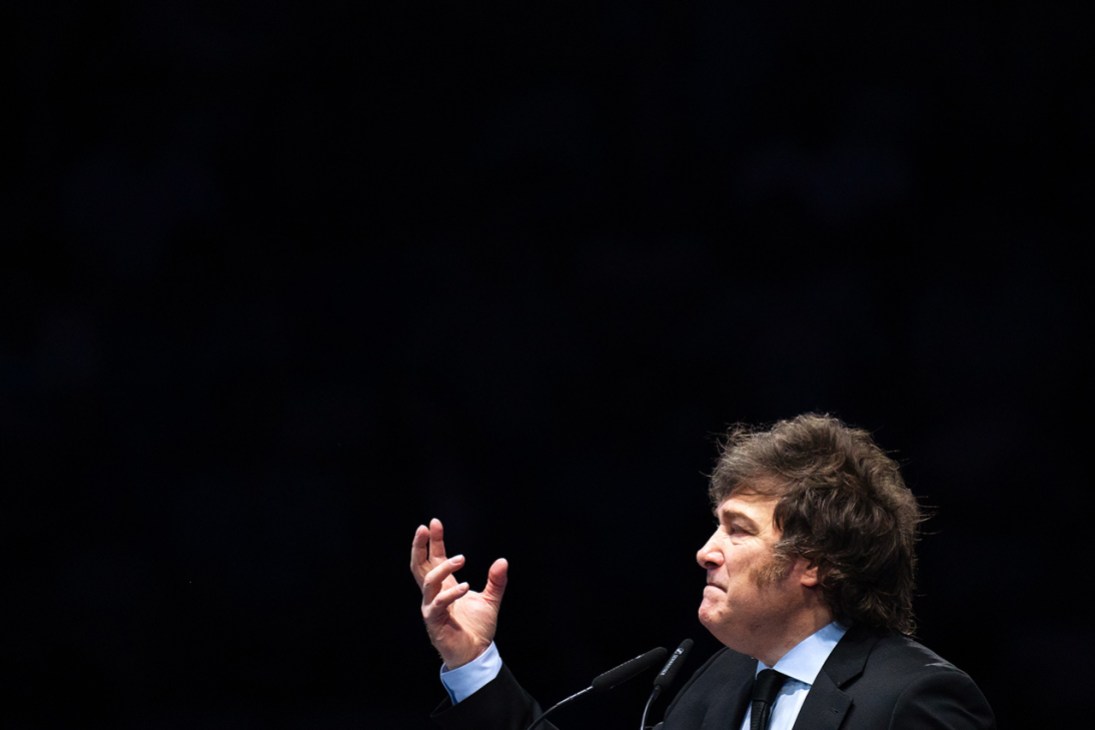
Now, Milei is putting this cautious optimism to the test. Last month the government announced that it would scrap elaborate rules aimed at preventing tax evasion and monitoring personal wealth. The goal? To coax an estimated $270bn (€230bn) of so-called “mattress dollars” back into the economy. Under the president’s scheme – officially dubbed the “Historical Reparation Plan for Argentines’ Savings” – citizens will be able to deposit dollars into bank accounts without fear of penalties or investigations into the source of their wealth. The government has tried to frame the move as part of a broader cultural shift in how it engages with the people. Or, as one lawmaker put it, “There will be no more persecution [of Argentines] as if they were Al Capone.”
The goal of the policy is to remonetise the economy and boost Argentina’s foreign reserves, which remain perilously low. Officials hope that the increased dollar circulation will stabilise the peso and boost fiscal activity. Whether or not the campaign succeeds, however, depends on whether Argentines can trust a banking system that has burned them many times before. The “mattress dollars” legislation is currently winding its way through Congress. Next up are legislative elections scheduled for October. If voters signal their satisfaction with Milei and hand his right-wing coalition a thumping victory, the stage will be set for deeper reforms. Crucially, the average Argentine might sleep better at night knowing that their cash is safely stowed away in a bank and not hidden under their bed.
Harris is a Monocle contributor based in São Paulo. For more opinion, analysis and insight, subscribe to Monocle today.
Buckle up, pens at the ready, tighten those laces and stay alert. The Faster Lane has spent the past week crisscrossing cities, dashing over nations and jumping the Atlantic. We start on the small, secluded terrace at the back of our HQ in Zürich, coffee in hand and opposite a man with a set of plans.
Build it better
My friend Todd is on a mini tour of Europe and is fresh from Copenhagen’s 3 Days of Design fair. We haven’t caught up in a while and there’s much ground to cover – new government in Canada, the joys of licensing your designs and collecting cheques and how Switzerland endures as a sanctuary of civility in a generally bananas world. On our second coffee order Todd explains that he’s about to start building a new house on Vancouver Island and pulls out some plans and a host of references from the late 1950s and 1960s. We scroll through black-and-white layouts and hand-drawn renders that were part of Canada’s post-war masterplan to create more housing in cities coast to coast. With nods to Richard Neutra, Rudolph Schindler and Charlotte Perriand, it was not only a mini masterclass in Canadian modernism but also a hopeful session that could serve as fresh inspiration for a country that needs to figure out a new housing strategy. After a while we got to Todd’s own plan – all low-slung lines, local timber, concrete blocks and forest views. The Carney government needn’t spend big on figuring out new typologies, it need only dig deep in the archives and unearth some exceptional designs that could make for desirable communities from Victoria to Halifax.
Superb San Sebastián
Depending on which index you consult, San Sebastián frequently ranks as Spain’s most liveable city and it only takes a day and an eve to figure out why it works. While the beaches and promenades are surely a plus, the winning ingredient is the city’s scale – a tight grid of six-to-seven storey buildings, galerías, plenty of trees and just the right mix of pedestrianisation and busy thoroughfares. As for real proof that it’s well and truly liveable, stand back and observe the locals. I don’t think I’ve ever seen a city with more mobility-constrained seniors out and about. From daughters walking their fathers to the markets and grannies with canes to dapper gents in wheelchairs and well-coiffed ladies with walkers, Sunday in San Sebastián was a parade of elderly residents enjoying the rhythm of a city with plenty of places to sip a beer in the shade or eat a pintxo or two in a buzzy bar. From what I could determine, this segment of Spain’s silver society still live in the city centre, have all the services that they require at street-level and judging by the general sense of conviviality and groups of women in their eighties chattering away in restaurants well into the evening, the Basque city offers more than a few clues about how we can keep older generations entertained, stimulated and living life to its fullest.
Licence revoked
I am starting a global campaign to close down all hotels that continue to think that it’s acceptable to put a glass box in the corner of a room and call it a bathroom. While San Sebastián got many things right during my three-day stay, the first hotel that I checked into was perhaps the worst example to date of a room not fit for double occupancy. Why? Why? Why would you want to have a barely opaque wall, a swinging door and all-hard surfaces right beside your pillow? Judging by the shiftwork in the breakfast room with one partner munching on their manchego while the other was back upstairs doing their business, no one is interested in this concept and it must stop. If hotels are so proud of this feature then they should celebrate it on their website and not hide the fact that they don’t believe in proper doors and the preservation of privacy. Smart cities should revoke licences or halt planning permission for hotels that don’t offer dignified digs for doing your thing.
Better setup
Should you make your way to San Sebastián, I can highly recommend the Hotel Arbaso in the city centre. This was the refuge I fled to. First, they have excellent bathrooms. Second, Narru restaurant is a treat. Third, top marks for uniforms and sunny, informed staff.
All in the details
Post-San Sebastián I jumped across the border to Biarritz for the film festival and saw Richard Linklater’s Nouvelle Vague on opening night. The film is about the making of Jean-Luc Godard’s Breathless and is a fun romp around Paris. The styling and scenes were all convincing until I spotted a UTA DC-10 in the background. The film was supposed to be set in 1960. The DC-10 didn’t go into proper commercial service until the early 1970s. All that said, it was my first time in Biarritz and I must return for longer than a film premiere.
Meanwhile…
Back in Canada, I’m flying from Ottawa to Toronto on an Air Canada Q400. As this is a short flight and the aircraft doesn’t climb that high, you get a good view of Ontario’s urban sprawl. I’m thinking back to my meeting with Todd and the future building plan and hoping that someone might suggest that for every house that goes up they need to plan at least five mature trees to create a canopy around future communities. It’s depressing to see how much construction has been permitted around Toronto with zero consideration for trees.
Happy Canada Day
As I head back across the Atlantic, Canada is gearing up to celebrate its birthday. I’m keen to see how the country marks the occasion off the back of Trump suspending all trade talks on Friday and Canada embarking on its biggest defence push in decades. Can the nation stay on course by continuing to pull together? Or will it stick with a narrative that looks backward, picks at old wounds and spends too much on celebrating differences rather than focusing on the social capital that comes with a strong national identity?
For more observations and adventures in ‘The Faster Lane’, click here.
As heatwaves stretch longer, affecting more people and cities across the world, many centres of human life are becoming increasingly unliveable. More greenery, shade and water would help but these alone aren’t enough. We also need cool spaces where the temperature, noise and light levels allow our bodies to rest. Fortunately, bringing urban temperatures down is a challenge that humanity has faced for millennia and there’s a lot that we can learn from ancestral technologies. For example, ancient Persian structures such as the yakhtchal or badguir offer effective but low-technology design solutions.
A yakhtchal is a vast communal fridge built from porous materials (eggshells, ground plants and even goat hair), designed to hold ice harvested in winter and keep food cool during summer. A badguir is a wind tower that catches hot air, channels it towards cold underground water, then circulates the cooled air back into living spaces: passive air conditioning making use of climate knowledge, materials and physics.
As a designer and artist, I have tried to reinterpret some of this thinking for today. With architect Imma Sierra, I designed a piece called “Pavillon de l’air”, a covered bench in a semicircle with a slanted fabric roof providing shading throughout the day. The roof is coated in beeswax, which allows rainwater to flow down ventilated terracotta walls below, where it’s stored. When heat warms the hollow bricks through which air can flow, the water is released, cooling the structure through evapotranspiration. The properties of the pavilion’s materials bring temperatures down without electricity.
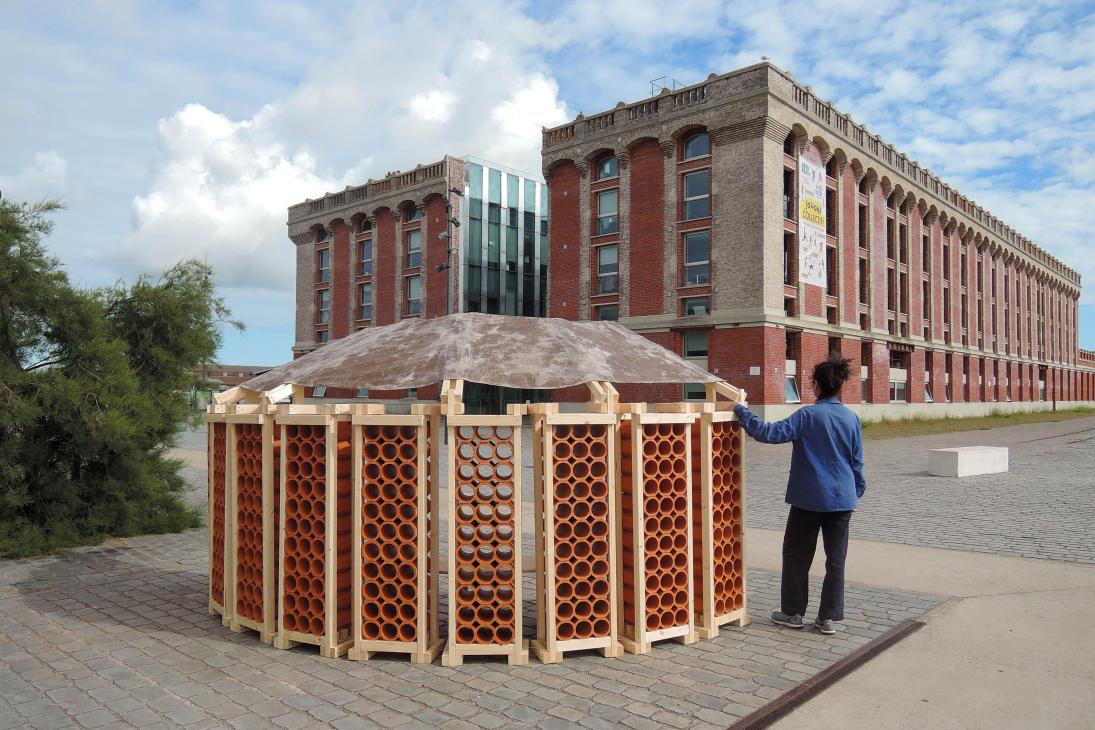
We also need to make more use of underground spaces. Beneath the streets of Paris (topping Monocle’s 2025 liveable cities index), for instance, there are old railway tunnels, underground chambers and more. These places – La Petite Ceinture, the quarries and catacombs – are naturally cool and quiet. We explored these subterranean locations for a project called “14C”, another collaboration with architect Imma Sierra, which we are showing at this year’s Venice Biennale. Though often inaccessible or neglected, such spaces have enormous potential as sanctuaries from extreme heat. By incorporating elements such as natural light, reflective surfaces, plants and art, we could turn them into inviting underground piazzas where people can gather, cool down and reset.
I collaborate a lot with scientists to ensure that my projects are grounded in data. This was how the “14C” project discovered that the temperature beneath Paris stabilises at a depth of 10.84 metres, a fact that could inform the creation of effective and sustainable cooling solutions in the future.
Though I like low-technology solutions, I’m not against innovation (“14C” wouldn’t have been possible without thermal-imaging cameras). Electric cars reduce noise pollution. Ancestral technologies and new ones don’t need to contradict each other. We must combine ancient and cutting-edge design, with a little more attention given to simpler solutions.
We hear a lot about smart cities but those conversations shouldn’t just be about sensors and data. A yakhtchal, a shaded piazza, a quiet underground tunnel that’s open to the public – all of these are smart. Climate resilience can come from new technology but also from making the most of what already exists: the sun, the wind, the materials at hand.
Read next: Monocle’s 2025 Quality of Life Survey: The world’s 10 most liveable cities
About the writer:
Clémence Althabegoïty is a Paris-based designer and visual artist. She is exhibiting her video installation “14C” at the 2025 Venice Biennale. As told to Monocle Paris bureau chief Simon Bouvier.
This essay originally appeared in the fifth installment of Monocle’s Companion series – browse the entire series in our shop.
You can’t deny it – 95 per cent of public art is bad. It’s a shame because it can spark conversation, connect communities and provide inspiration in ways, and on a scale, that a museum or gallery could only dream of. Civic sculpture has always been intertwined with the act of solidifying political, religious and social power. Today, however, it’s mostly a way for local governments and property developers to feign interest in the community in an attempt to spruce up a new development or motorway intersection.
The worst example of municipal art must be the CowParade and its many copycat projects. And you can blame the Swiss for that. In 1998, Zürich-based artistic director Walter Knapp invented the original concept of the cow parade in an exhibition called Land in Sicht (roughly Countryside in View). Since then, similar kinds of fibreglass sculptures have been commissioned to artists to decorate and to deposit in cities around the globe. There are dolphins in Atlanta, owls in Birmingham, dragons in Norwich, cats in the Catskills and lobsters in Nova Scotia. Painted animal statues now populate far too many cities. Some people seem to think that these figures encourage tourism and civic pride. “Buddy Bears”, for example, were created by Austrian sculptor Roman Strobl at the behest of German business couple Klaus and Eva Herlitz. The aim of these animals was to provide “an international symbol of collaboration between nations of what can be achieved when we work together toward a better tomorrow.” They stand across Berlin with their arms outstretched, friendly, optimistic – and truly bad.
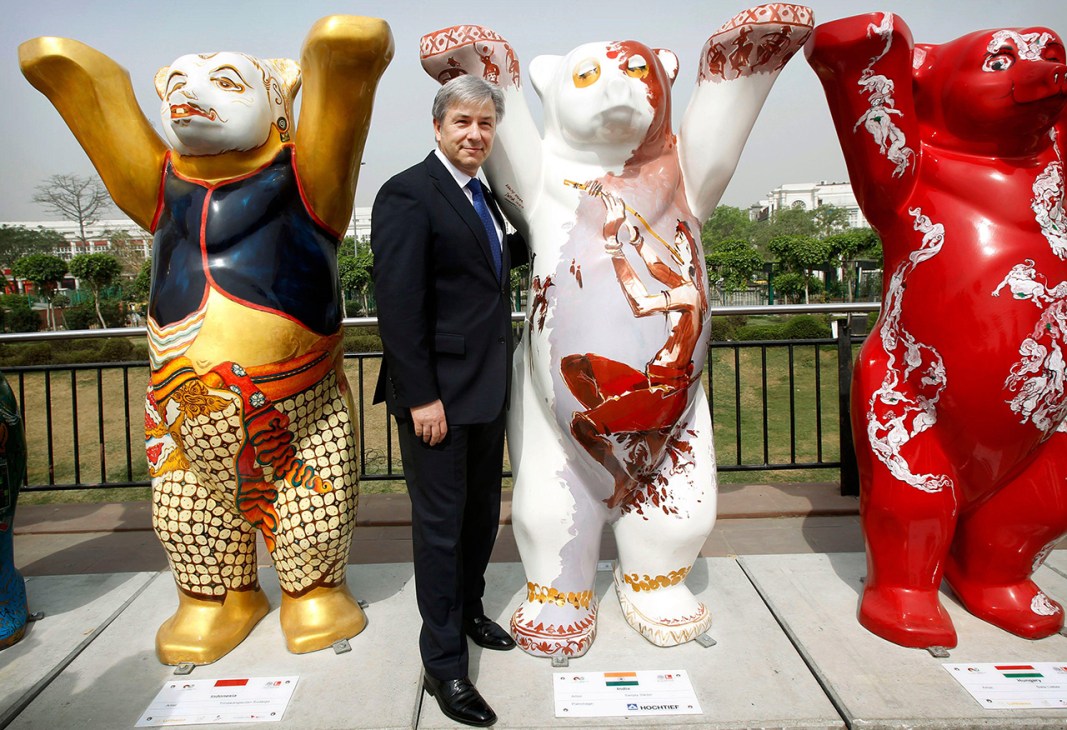
But there are plenty of wonderful, thought-provoking exceptions. Jean Tinguely’s whirling fountain near the Centre Pompidou in Paris; the Barbara Hepworth relief on John Lewis on London’s Oxford Street; David Hammons’ haunting pier-structure “Day’s End” in New York; Paul McCarthy’s delightful Santa with butt plug in Rotterdam and Oslo. Richard Serra, Gelitin, Isamu Noguchi, Ruth Asawa and Daniel Buren have all also created great public artworks. These are works that help a city to define itself. They bring humour, intelligence and beauty to their locations and have the power to lionise communities and transform urban space into a canvas. They make us experience our surroundings in a different way.
Anish Kapoor’s 2006 “Cloud Gate” at Chicago’s Millennium Park was the pinnacle of the big tourist-destination sculptures. A highly polished, 110 tonne curvaceous blob, measuring 20 metres long and 13 metres wide. The zen-like mercurial work is surprisingly joyous to look at in person, the sky reflecting in its ultra-shiny exterior. Even CowParade had a redeeming moment when David Lynch created a headless cow with entrails pouring out of its fibreglass body, etched with the words “EAT MY FEAR” in 2000. It was rejected from the official CowParade by the city of New York but was given a temporary home in Stockholm in 2004.
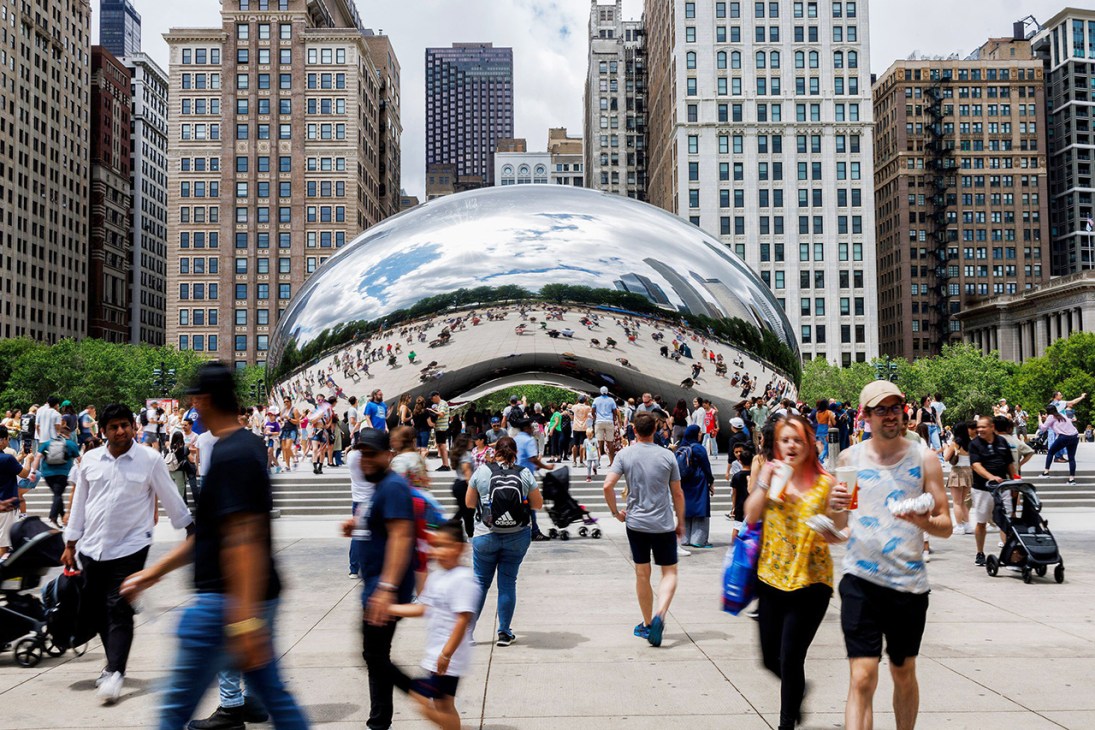
The problem with municipal art often lies in the way that it is commissioned – blandified by committees so it appeals to all. Artwork often reflects the motivation behind its existence and those in charge can be more concerned with their own legacy than commissioning work that resonates with its audience.
Public art can transform a city. But it can only exist when the artist resists power plays and does not seek universal approval. We need pieces that take risks; that work with their environment; and that play with scale, time and material. And, most of all, we need work that celebrates joy.



